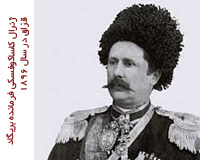Among the most important tools of political and also military power of Czarist Russia in Iran was the Cossack force. The Cossack force which was founded in 1879 during Naser-al-Din Shah’s monarchy and with the help of the Russian officers was considered ...
Even though all the expenses of this force was paid by Iran without interfering in the amount and manner of its use. in this way, “Iran Cossack brigade, meaning the sole disciplined armed force was formed by Russian officers and was practically under their command and they received their agenda from the Cossack commandership center (in Russia). The budget of this organization was directly paid to this brigade’s commandership by the Russian loan bank on behalf of Iran and Iran government had no supervision in this regard.”
Mohammad Ali Sayah Mahalati states that in 1944 the number Cossack forces were about one thousand which were at the same time the most disciplined military force in the country. But despite all the expenses and stipend being paid by Iran they were under the influence of the Russian embassy. wages and current costs of the Cossack force was directly deposited from northern customs revenues in to the Russian loan bank and the bank officials paid for these forces’ wages according to the Russian embassy’s order and without notifying Iran authorities. M. Pavlovich writes about the Cossack’s forces and their undue interference in Iran political affairs saying: “wages of the officers and soldiers of Cossack brigade was in the hands of the Russian government. The brigade commander acted on political affairs with the Russian ambassador in Tehran. The brigade’s commander was determined and appointed from Saint Petersburg. This commander received its wages from the loan bank and gained necessary education from the Czarist Russian embassy. In one word, this commander was the direct agent of Petersburg’s government”.
It was the same Cossack force that bombarded the parliament during the constitution under commandment of Lyakhvf. the loan bank which had the main role in providing the Cossack forces’ financial matters, depended on this force for the provision of its employers’ and its own necessary financial and life security. in addition to guarding the bank’s branches in Tehran and different states of Iran, the Cossacks were responsible to provide security during bank transfers and also on its’ managers trips inside the country. most of the people who have investigated the Cossack’s performance in Iran have emphasized the destructive role of this force in the political-military life of Iran and they have especially stated that the loan bank played the most role in gaining the goals of that force regarding protection of Russia’s political-military wishes in Iran by regular payment of this force’s wages and current expenses. Wilhelm Litton, who was in Iran on the verge of the first world war, writes about the political-military record of the Cossack force and the role of loan bank in strengthening this force saying: “Cossack brigade was founded in Tehran in 1879, its commanders included:
1879 Dmantvvych
1882 Chrkafsky
1885 Cosmin Karavayn
1890 Shnvyr
1896 Kasakvfsky
1903 Chrnvzvbvf
1907 Lyakhvf
1909 Prince Vadbvlsky
The Cossack brigade was an Iranian military force the orders of which were issued by the Russian officers and they were under supreme commandership of Russia and they received 342,000 tomans (about 1,200,000 mark) annually for their expense which increased to 900,000 tomans (about 3,500,00 mark) in 1913. This amount was directly paid by the loan bank in Iran and from custom revenues of the north of Iran.
The money was spent by the commander and no receipt was ever presented to the government or Iran treasury. The number of Cossack guards equaled to 1600 people which increased in 1913 due to founding of branches in Tabriz, Rasht and Hamadan. Efforts regarding the use of Cossacks instead of gendarmes in northern roads of Iran did not materialize due to prince Vadbvlsky, their commander’s resistance.
Cossack Brigade was a royal military force, Russian security guard and parade for the Shah and the Russian envoys, while from the beginning of its establishment in year 1879 no Russian officer was murdered or injured. The Swedish officers who established Iran gendarme in 1911 lost six of their officers during service only in 1914. Regarding the importance of commandership post of the Cossack brigade was like a gold mine but the brigade officers behaved naturally and simply with this authority.
After Russia’s defeat in 1917-1918 the Cossack brigade joined the other Russian forces who were taken under service by England.
The last and must be noted, the most important masterpiece of the Cossack force in Iran was participation in the 1299 English coup. The Cossack force which had bombarded the national parliament in 1908 under commandership of Lyakhvfand (temporarily) ended the new life of Iran constitution with a military coup, imported more gruesome blows on Iran constitution with the 1299 coup.
https://iichs.ir/vdcb.sb8urhb00e4pr.html
iichs.ir/vdcb.sb8urhb00e4pr.html
